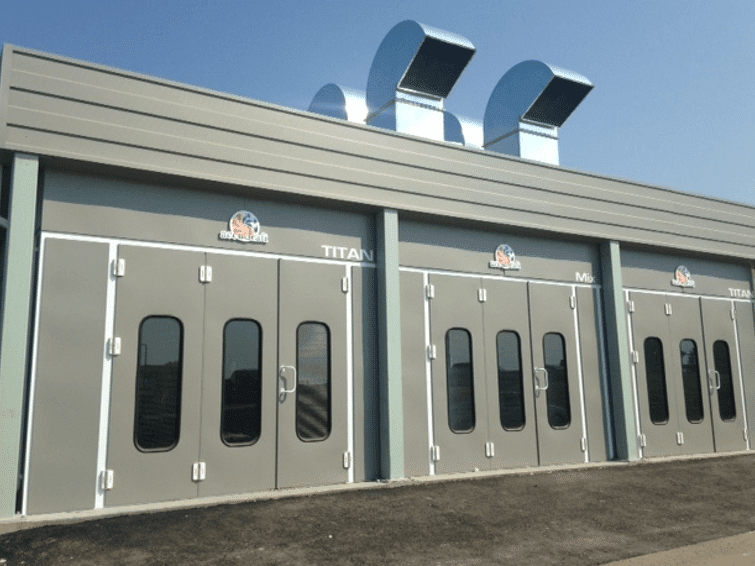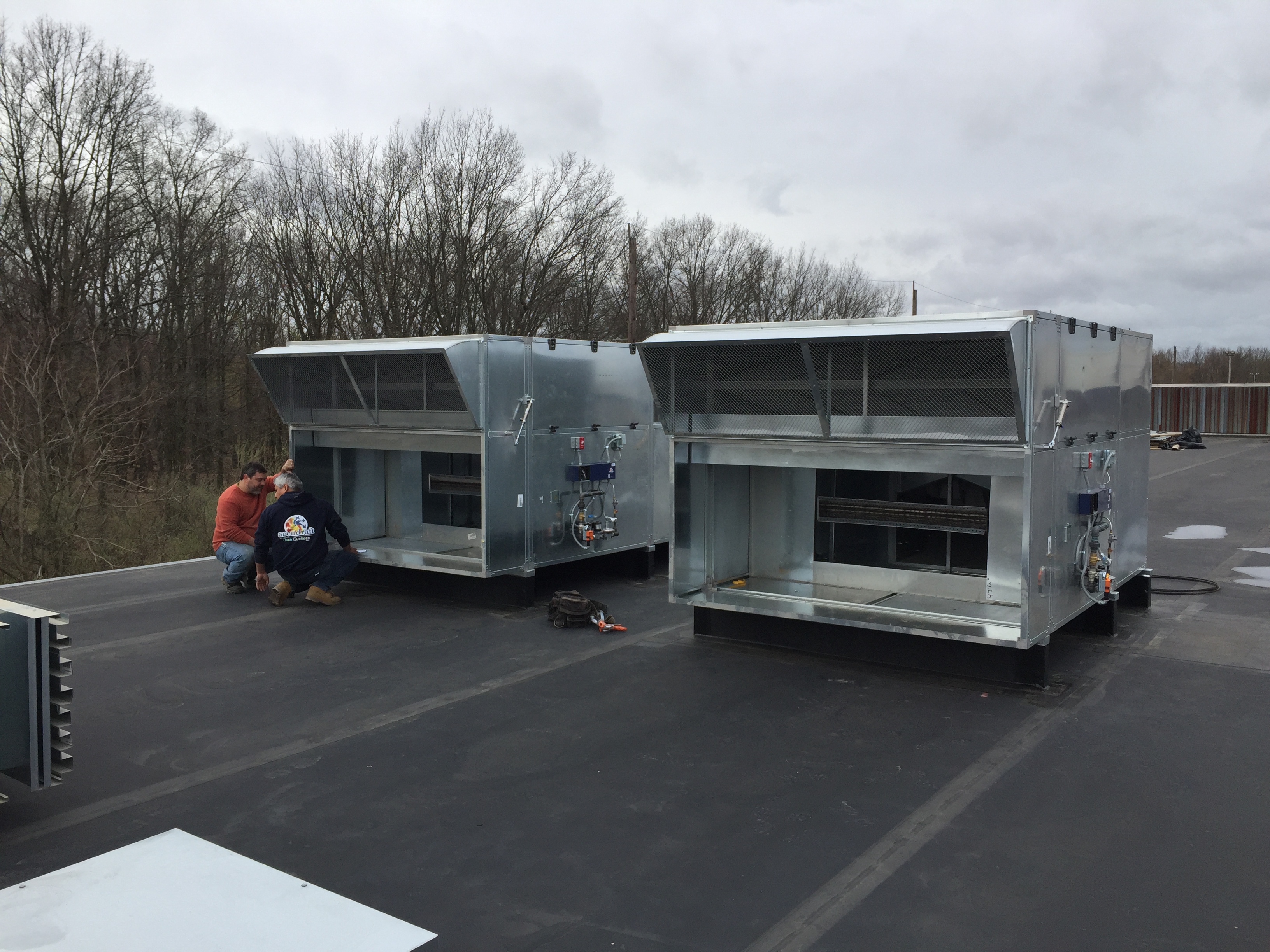As winter approaches dropping temperatures can affect spray booth productivity in body shops across the country. Ideally you want San Diego weather, a cool 60 to 75 degrees for your outdoor temperatures year round. But, that’s not always possible. So how do the seasons affect your paint booth’s productivity and what can you do to keep your spray booth running on all cylinders year round?

Temperatures affect the quality of your paint finish, curing times, and the air quality of a shop. Ideally, your garage should maintain a pleasant middle temperature outside of the paint booth at all times. There should be no additional moisture in the air and the space inside and outside of your booth must allow for proper ventilation.
That’s the kind of shop that can endure both winter snaps that dip below zero and hot humid summers on the Florida coast. You may be operating a body shop in freezing North Dakota or running a collision repair shop along the Gulf of Mexico. Different seasons create different productivity problems for your spray booth.
Winter presents probably the biggest problem for paint booth operators particularly in the north where temperatures can stay near freezing for months at a time. Not only does it add up to more energy costs to heat your shop and to keep the temperature high inside of your booths, but it also causes problems for your paint jobs.
One problem specific to cold temperatures in the winter is the condensation issue. When it’s chilly outside and you start up the heat in your car, condensation shows up on your windshield in rearview. The same applies for cars coming in out of the cold into your heated paint booth.
Condensation can mix with your paint chemicals causing tiny bumps to appear in your paint finish. Two, cold temperatures can cause your paint to thicken up as you spray leaving filmy residue on your finish and it makes it harder for the paint to adhere to hard surfaces.
Thirdly, it takes much longer for cars to dry when it is cold outside which can cause your paint to run completely ruining the job. When that happens, you have no choice but to go back to the drawing board by removing the paint job and starting all over again.
The ideal body shop operates in a climate where it feels like spring year round. But actual spring in the Midwest, North, and Northeast brings with it its own set of problems. Unlike mostly steady climates such as San Diego, regions where there are four different seasons could mean having a spring that brings a a wide variety of temperatures.
A spring day in Ohio can start out in the 30’s, zoom all the way up to the 80’s, and end with a flash flood of rain dropping temperatures down into the 60’s. All in one season you could have to deal with the problems that come with operating a paint booth in hot humid climates as well as cold climates.
How do you control the temperatures inside of your body shop and paint booth when the temps outside can be so erratic? Keep in mind also that the size of your shop will factor into how much your spray booth’s productivity is affected.
Humidity is the enemy in summer. Like with condensation in the cold, humidity introduces water into the air. That moisture mixes with your solvents and results in poor paint finishes. In humidity, the result is large bubbling as your paint job dries too quickly and chemicals react badly.
Heat generally is a good thing for paint booths. Most booths operate at an indoor temperature around 150 degrees. Dry heat areas like Arizona and Nevada don’t present the hot moisture problems that come with humid areas like Florida and the Midwest in summer.
That said if your paint booth technicians are sweating and dripping moisture as they perform their jobs, it will affect your booth’s productivity. You will ruin the finish and have to start all over again.
Just like spring, the fall in the Midwest and the North can bring wild temperature swings. Fortunately humidity tends to drop in cooler temperatures of the fall. Yet frost, condensation, and cold temperatures will present the same challenges in the fall as they do in the winter just as hot fall days have the same affect on your spray booth’s productivity as summer temps do.

These tips will help you when operating your paint booth in a cold climate. Your solution may require a combination of two or three of these tips. And depending on the time of year and where you live, one heat source may be more cost effective than another.
Temperature control in winter has as much to do with the weather outside as it does with the heat inside of your shop. One factor that will influence the type of heat you need and how much of it is the size of your shop.
Smaller shops can get away with using small kerosene heaters to warm the work area. However, kerosene is combustible and space heaters in a body shop are never a good idea. It may be cheaper but it is bad for indoor air quality.
A well insulated shop can save on energy costs using electric heat. It’s easier to maintain consistent indoor temperatures that way and it is cleaner. Overall though, electric heat is going to cost more than propane for instance or gas.
As a general rule, the larger the shop the higher the heating costs. However, using propane or gas heat, you could run a four bay shop for just a couple hundred bucks a month.
Warm climates have one main issue and that is humidity. But as mentioned before, if your workers are too hot and sweating all over the place, it can have an effect on your paint jobs costing you time in productivity.
In warm climates you have really one choice and that is to use central air. In northeastern states where summer temps rarely get above 80, just using some fans and opening windows can keep the shop cool enough to not affect jobs. But if you are living along the southeastern border of the U.S. that is likely not an option.
As with paint booths in winter, if you have a well insulated shop, you could run your central air all summer long and still save on energy costs. One way to keep control temperatures in the summer is to isolate your bay areas from your general office areas. That way you won’t have to waste cooling energy where it is not really needed.
The beauty of buying your spray booth from Accudraft Paint Booths is that we have distributors all across the country. In your area, whether it is sunny southern California or the blizzard cold northeast, our skilled and knowledgeable distributors can help answer your questions about operating your spray booth.
If you are interested in purchasing a paint booth from Accudraft, we are ready to help you pick the right booth for your shop. Simply fill out our online contact form to have one of our representatives contact you with more information.